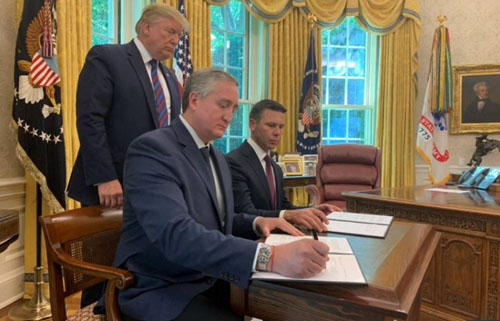by WorldTribune Staff, July 30, 2019
While the Democrat-controlled House split town for summer recess on July 26, the White House noted that President Donald Trump was working to secure the border — and winning.
Trump on July 26 secured an agreement with Guatemala to have migrants apply for asylum there rather than in the U.S.

Hours later, the Supreme Court cleared the way for construction on the border wall under Trump’s emergency declaration.
The White House, in a press release, contrasted Trump’s day compared to Democrats’ on July 26:
“While President Trump was busy securing this deal with Guatemala, House Democrats were gone on a six week vacation – leaving without doing anything meaningful to solve this crisis.”
A tweet from the Democratic Cloakroom on July 25 at 6:31 p.m. said: “No further votes are expected in the House tonight. Votes are no longer expected in the House tomorrow, Friday, July 26, 2019. This is a change from the previously announced schedule. Next votes in the House are expected on Monday, September 9, 2019 at 6:30 p.m.”
“President Trump continues to take action to address the dire crisis at our southern border, while Congressional Democrats have done nothing,” the White House statement said, noting that the president had also secured an agreement in which Mexico agreed to crack down on the surge of illegals flooding the border.
“Mexico has sent thousands of soldiers to their border to stop migrants from making their way to the U.S.,” the White House said.
Trump on July 26 also issued guidance instructing asylum officers to make sure migrants are fleeing state-sanctioned violence before they are granted asylum.
“The Trump administration is trying to throw everything it can at this problem,” said Jessica Vaughan, policy studies director at the Center for Immigration Studies.
The agreement with Guatemala could allow the U.S. to deny tens of thousands of asylum-seekers the chance to ask for status before they reach the border, the White House said.
“We’ve long been working with Guatemala, and now we can do it the right way,” Trump said in the Oval Office after signing the deal with Guatemalan Interior Minister Enrique Degenhart.
Under the agreement, a Honduran family or an El Salvadoran national “will apply for asylum in Guatemala rather than making the journey to the U.S.,” the White House said. “Migrants that do make the journey to our southern border will be removed back to Guatemala to apply for asylum there.”
The agreement, the White House said, “will further efforts to combat the violent human smuggling organizations that are exploiting migrants for profit. Women and children migrants have been known to suffer horrible violence at the hands of these organizations.”
The Supreme Court, in a 5-4 ruling, paved the way for Trump to use Pentagon money to build more of the border wall.
The high court ended a lower-court blockade of the Trump administration’s budgeting moves, limits that a federal district judge in California and later an appeals court had imposed while the case was being argued on the merits.
The president’s relocation guidance directive:
A message sent by the acting director to USCIS asylum officers regarding asylum and internal relocation guidance.
Release Date: July 26, 2019
The crisis at our Southern border continues to be severe. Every day, USCIS faces an unprecedented number of aliens overwhelming our asylum system, many of whom are ineligible for asylum and are attempting to enter and remain in the country in violation of our laws. This guidance further clarifies current regulations and policies that are already in place regarding internal relocation of an alien in their home country, eliciting testimony for credible fear screenings, and documenting outcomes. As detailed in the Department of State country conditions reports for these countries, private violence is not pervasive across the entirety of each Northern Triangle country. I am writing to provide a reminder of the importance of assessing a person’s ability to safely relocate to another part of his or her home country. This is an important regulatory factor in the consideration of credible fear screenings and determinations.
When confronted with evidence of private violence, you must consider whether internal relocation is possible. 8 CFR 208.13(b)(3) provides that factors adjudicators should consider include but are not limited to “whether the applicant would face other serious harm in the place of relocation; ongoing civil strife in the country; administrative, economic or judicial infrastructure; geographic limitations; and social and cultural constraints such as age, gender, health and social and family ties.”
Many of the cases arising at the Southern border are cases of individuals that are willing to engage in costly and dangerous international travel – neither of which would be necessary if they sought refuge within their home country, particularly given the fact that there are areas that are generally very safe within each of the countries that currently make up the bulk of our credible fear cases. Asylum officers should be eliciting testimony to determine if the alien attempted to internally relocate to any safe areas prior to the alien’s travel to the United States.
The Asylum Division work is very important, and your dedication to the mission has not gone unnoticed. If you have any questions concerning the procedures contained in the memorandum, please contact Asylum Headquarters. Thank you for your continued commitment to our mission and to safeguarding the integrity of the U.S. immigration system.
Intelligence Brief __________ Replace The Media
